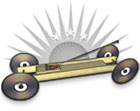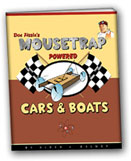Mousetrap Cars: How to Make a Car Reverse
Learn how to build a reversing mousetrap vehicle so that it will come back to the start. You cannot build a winning mousetrap racer until you know the basics.
Just one of the many mousetrap vehicle contest is to design a mousetrap car that will travel to a set distance and them come back to the start line in the shortest amount of time. Rest assured that there is no need to over think this contest, any mousetrap car can be made to go forward and then come back depending on how you wind the string around the drive axle. To make a reversing mousetrap car go forward and then come back you will need to know how to "back-wind" the string. Back-winding the string it a technique where you first wind the string around the axle in one direction and then rewind the string in the opposite direction.

step #1: The string is attached to the mouse trap's lever arm and then hooked to the drive axle using a loop knot tied at the other end of the string that is designed to "catch" a hook attached to the drive axle.

step #2: The string is wound around the drive axle by turning the wheels in the direction opposite to the vehicles motion needed to move the car back to it's starting point. The string you are winding in this step will be the string that pulls the car home (the back-wind) after the mousetrap car has reached it's stopping point.

step #3: After winding the correct amount of string around the drive axle that is needed to pull the mouse trap car back, loop the string around the axle hook and begin winding the string in the opposite direction as before.

step #4: The photo above shows the string looped around the axle hook and being pulled tight. Make sure that you wind the "forward-wind" string on the opposite side of the axle hook so it does not become tangled with the "back-wind" sting.

step #5: The photo above shows the "forward-wind" string being wound around the drive axle. Notice that the string is being wound on the opposite side of the axle hook as the "back-wind".

step #6: Once the car is released, the string is pulled off the axle it cause the wheels to rotate propelling the vehicle forward. The only hard part of this technique is finding the "turn-around" point on the string; the "turn-around" point on the string is where you change from the back to the forward-wind. Through trial and error you can find the exact "turn-around" point on the string and then mark it, making winding easier.
Calculate the string length
Calculate the amount of string needed to pull the vehicle to the turn around point. Use the following steps:
step #1: Calculate the number of wheels turns needed to target:
Number of wheels turns needed = (the target distance) divided by (Drive wheel circumference)
step #2: Calculate the length of string needed to the turn around point:
Length of string = number of wheel turns needed multiplied by (drive axle circumference)

step #3: Measure from the tip of the lever arm to the turn around point and use a marker to mark the point. (The turn around point was calculated in step #2)

step #3: Wind the string on one side of the axle until you reach the mark on the string from step #3; then, loop the string back around the axle hook and begin back winding the rest of the string in the opposite direction and on the opposite side of the axle hook.
Adding Traction to Wheel
Adding traction to a wheel will give the wheel more grip and greater stopping potential. One way to increase the traction of a wheel on smooth surface is to add a rubber traction tread that has more grip than the original wheel alone. Various brands of rubber may have more grip than another brands of rubber so it is always best to experiment. Rubber bands can be stretches and placed directly over a wheel or the middle section of a balloon can be cut and then also stretch around a wheel to help increase the traction. The balloon trick should not be used on Doc Fizzix DVD-layers.

step #1: cut the center section of a rubber balloon as pictured.

step #2: stretch the cut section of the rubber balloon around the CD/DVD.

alternate option: rubber bands can also be stretched around a wheel to increase the traction.
Ultra Stick Foam Wheels
Doc Fizzix's Ultra Sticky Foam Wheels are made from a lightweight urethane that is specially designed to grab the road and provide maximum traction for maximum acceleration and stopping. While the rest of the field is spinning their wheels at the start line or skidding past the finish, your racer will be rocket to the perfect finish. These wheels are manufactured specifically for Doc Fizzix Products and are the same wheels that were used on Doc Fizzix's world record setting mousetrap racer that traveled 5 meters in under 1.2 seconds. By far, the biggest secret to Doc Fizzix world record setting speed-trap racer was the use of the ultra sticky foam wheels that were essential in keeping his Speed-Trap Racer from spinning out at the start line and providing maximum traction to the road. Ultra sticky foam wheels are 2-inches in diameter and machined to fit a 5/32-inch axle.

bonus tip: ultra-stick foam wheels gives all the traction you will need for quick accelerations and instant stops..
*Can't find what you're looking for? Ask Doc Fizzix »




